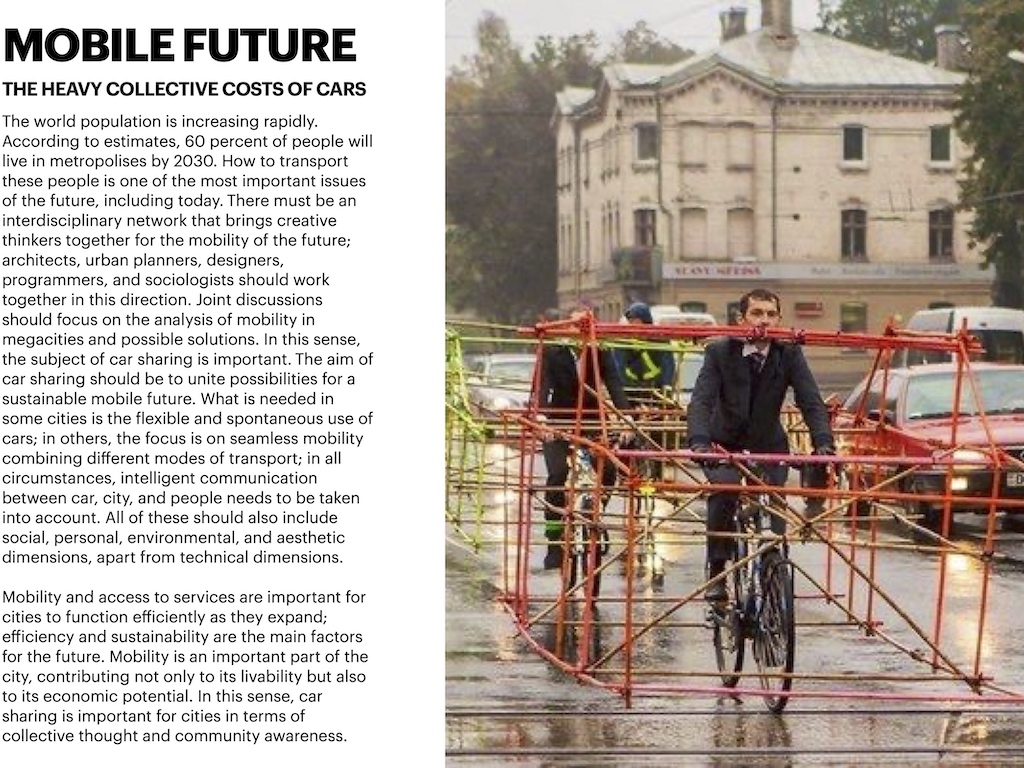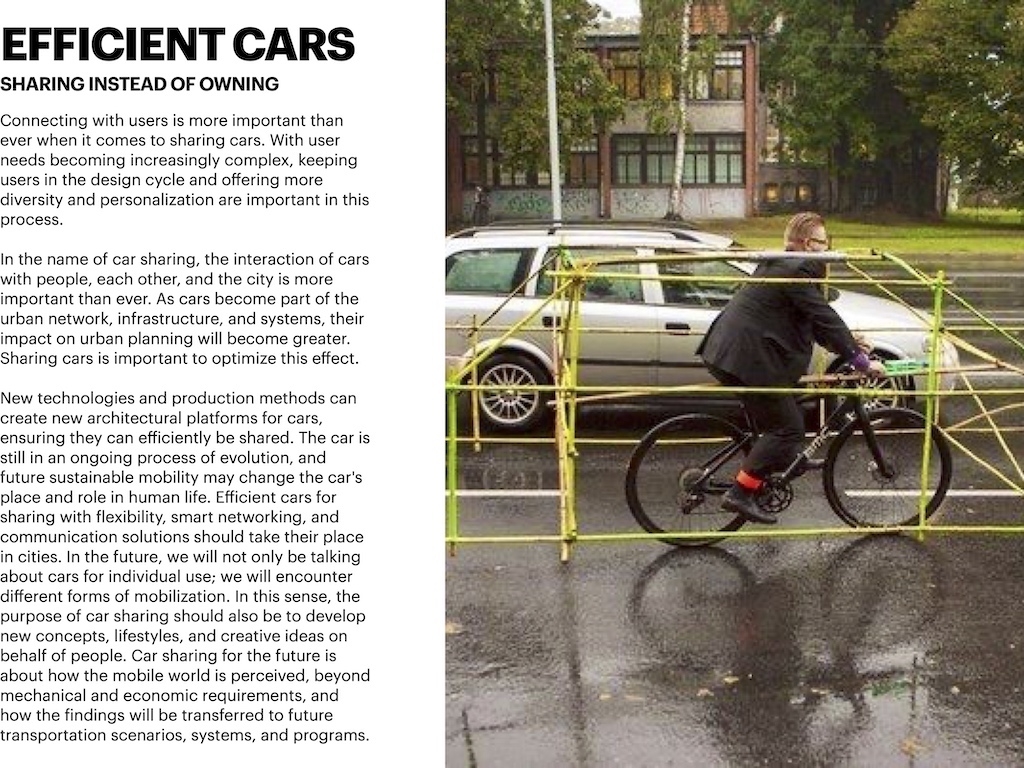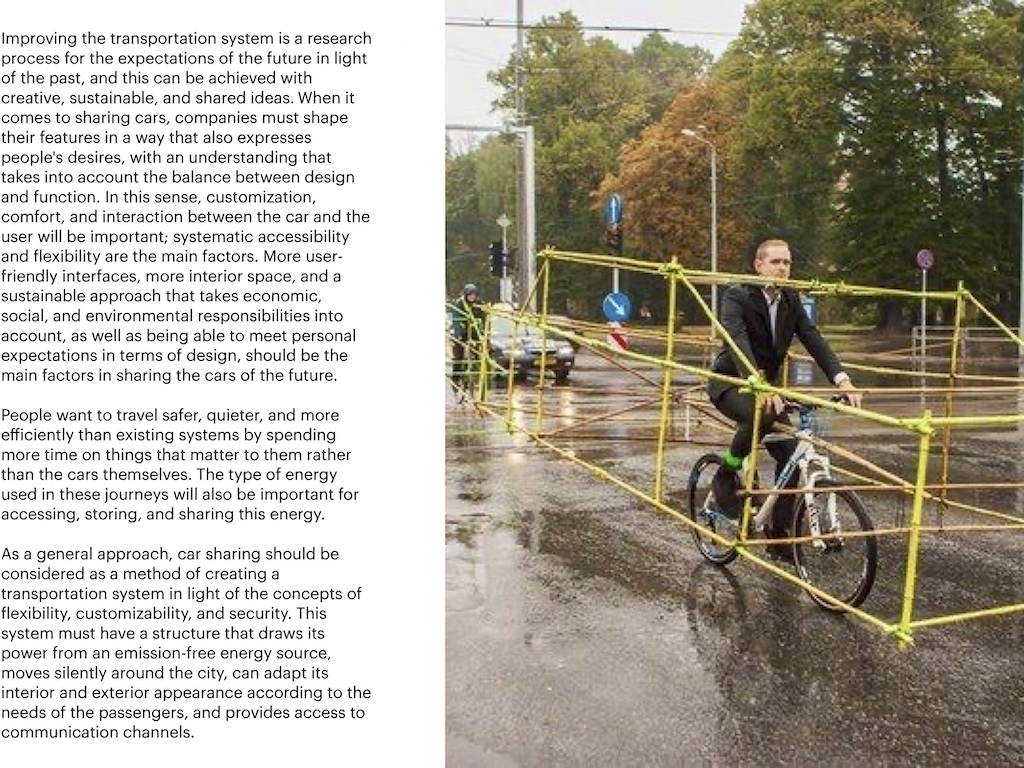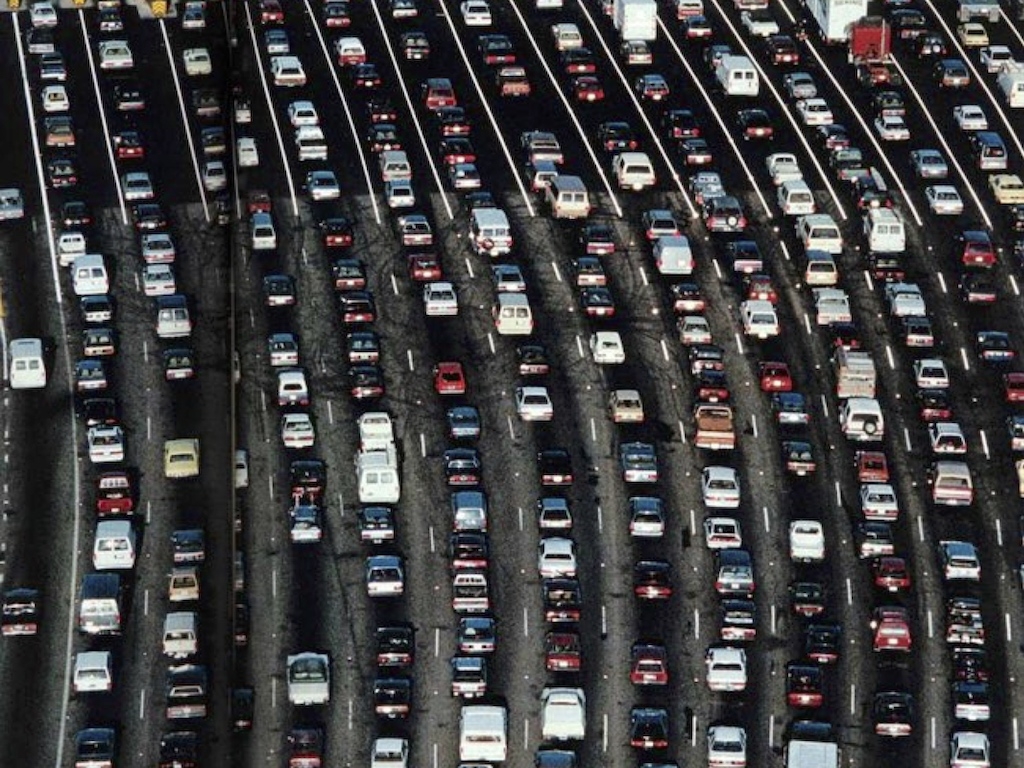COURSE
INNOVATIONS FOR SUSTAINABILITY
University of Basel, Urban Studies, MA Critical Urbanisms, Fall 23
Machteld Simoens
MA Critical Urbanism-University of Basel
MA Critical Urbanisms - Instagram
CAR SHARING
SHAPING THE SUSTAINABLE CITY AND MOBILITY OF THE FUTURE







CAR SHARING
SHAPING THE SUSTAINABLE CITY AND MOBILITY OF THE FUTURE
MOBILE FUTURE
THE HEAVY COLLECTIVE COSTS OF CARS
The world population is increasing rapidly. According to estimates, 60 percent of people will live in metropolises by 2030. How to transport these people is one of the most important issues of the future, including today. There must be an interdisciplinary network that brings creative thinkers together for the mobility of the future; architects, urban planners, designers, programmers, and sociologists should work together in this direction. Joint discussions should focus on the analysis of mobility in megacities and possible solutions. In this sense, the subject of car sharing is important. The aim of car sharing should be to unite possibilities for a sustainable mobile future. What is needed in some cities is the flexible and spontaneous use of cars; in others, the focus is on seamless mobility combining different modes of transport; in all circumstances, intelligent communication between car, city, and people needs to be taken into account. All of these should also include social, personal, environmental, and aesthetic dimensions, apart from technical dimensions.
Mobility and access to services are important for cities to function efficiently as they expand; efficiency and sustainability are the main factors for the future. Mobility is an important part of the city, contributing not only to its livability but also to its economic potential. In this sense, car sharing is important for cities in terms of collective thought and community awareness.
Over time, the collective costs of cars became abundantly clear; uncontrolled urban sprawl, air and noise pollution, climate change, pedestrian safety, and accidents are just some of the consequences. Modern urban planning is responsible for this; urban design should focus on how to bring people and places together in the most effective way by creating cities that focus on accessibility rather than simply increasing the length and capacity of individual transportation infrastructure that emphasizes the use of automobiles. The mobility of the future needs to be better planned, sustainable, and safer for everyone and everything. For the new generation, the car has no importance as an individual status symbol; as other values gain importance in the name of individual transportation, the expression of luxury has become secondary; it matters sharing instead of owning and integration into sustainable mobility. New needs have emerged, such as establishing more seamless networks with society and a more comprehensive interaction with the environment, all of which will lead to a new understanding of cars and new systems of use and sharing that will make these changes possible. The new role of the car in society, shaped by sharing, will create new spaces for individual forms of mobility.
Manufacturers have already solved the function of the car; producing a car that blends speed, freedom, and luxury should not be the main goal of these companies; instead, they should design cars for a sustainable and ecological future, and the collective use of cars should be at the center of both a system and a program.
EFFICIENT CARS
SHARING INSTEAD OF OWNING
Connecting with users is more important than ever when it comes to sharing cars. With user needs becoming increasingly complex, keeping users in the design cycle and offering more diversity and personalization are important in this process.
In the name of car sharing, the interaction of cars with people, each other, and the city is more important than ever. As cars become part of the urban network, infrastructure, and systems, their impact on urban planning will become greater. Sharing cars is important to optimize this effect.
New technologies and production methods can create new architectural platforms for cars, ensuring they can efficiently be shared. The car is still in an ongoing process of evolution, and future sustainable mobility may change the car's place and role in human life. Efficient cars for sharing with flexibility, smart networking, and communication solutions should take their place in cities. In the future, we will not only be talking about cars for individual use; we will encounter different forms of mobilization. In this sense, the purpose of car sharing should also be to develop new concepts, lifestyles, and creative ideas on behalf of people. Car sharing for the future is about how the mobile world is perceived, beyond mechanical and economic requirements, and how the findings will be transferred to future transportation scenarios, systems, and programs.
Improving the transportation system is a research process for the expectations of the future in light of the past, and this can be achieved with creative, sustainable, and shared ideas. When it comes to sharing cars, companies must shape their features in a way that also expresses people's desires, with an understanding that takes into account the balance between design and function. In this sense, customization, comfort, and interaction between the car and the user will be important; systematic accessibility and flexibility are the main factors. More user- friendly interfaces, more interior space, and a sustainable approach that takes economic, social, and environmental responsibilities into account, as well as being able to meet personal expectations in terms of design, should be the main factors in sharing the cars of the future.
People want to travel safer, quieter, and more efficiently than existing systems by spending more time on things that matter to them rather than the cars themselves. The type of energy used in these journeys will also be important for accessing, storing, and sharing this energy.
As a general approach, car sharing should be considered as a method of creating a transportation system in light of the concepts of flexibility, customizability, and security. This system must have a structure that draws its power from an emission-free energy source, moves silently around the city, can adapt its interior and exterior appearance according to the needs of the passengers, and provides access to communication channels.
NEW CONCEPTS
MAXIMUM INTEGRATION
It offers easy circulation and parking facilities, a flexible and customizable spatial setup, and access to specific communities based on specific preferences.
It sets up remote access and configurations over the internet and offers smart charging methods for electric cars.
It prioritizes passengers' safety and visual and auditory interaction with the outside world, uses a sustainable energy source, and shares this energy with other cars when necessary.
It offers the ability to personalize cars to better align with users and provides maximum integration between cars, connectivity, and information sources.
It can transform itself according to the user's needs. Cars use modular, adaptable, and open platforms.
It offers the ability to drive many different cars without ownership liability.
It sees the car as a product and creates shared ownership models in order to reduce the number of cars in the city as a service.
It aims for low user costs, eliminating ownership costs, parking fees, and maintenance costs. Applies a shared ownership methodology.
It provides new socialization areas and ways of discovery for users.
It establishes a symbiotic relationship between the car and the architecture based on mutual benefit in terms of energy use.